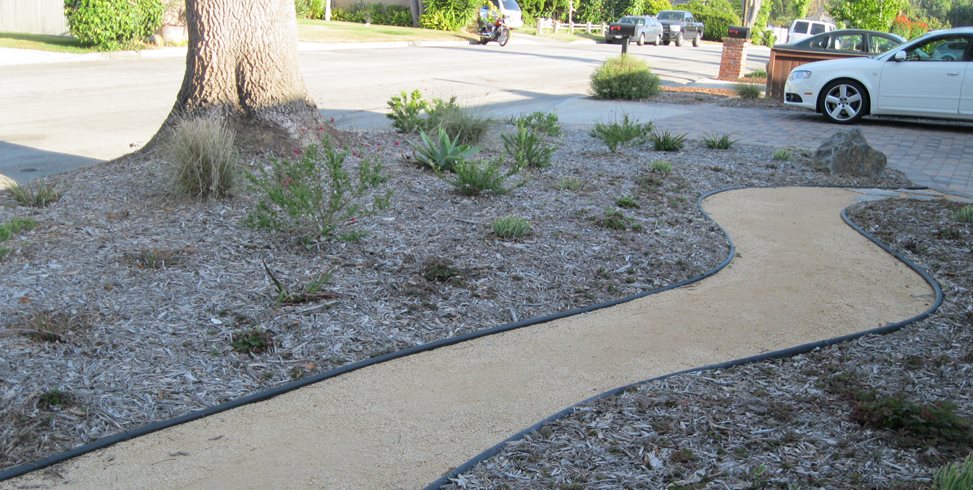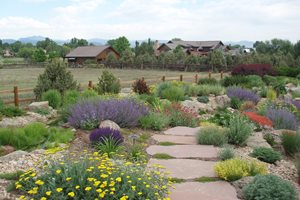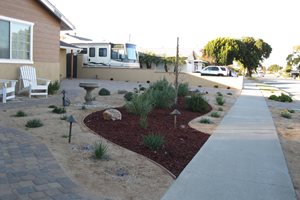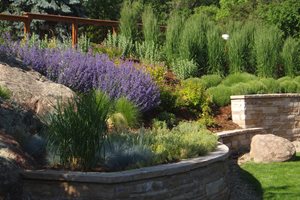Xeriscape Design Considerations
Important considerations for designing a xeriscape gardenA landscape designed with xeriscape principles in mind will make the most of any naturally-occurring water, while minimizing how much additional water is needed through careful design and plant selection. Here, landscaping professionals share their tips for designing low-water landscapes.
Why xeriscaping?
People develop an interest in xeriscaping for a few reasons. Elizabeth Przygoda-Montgomery of Boxhill Landscape Design in Tucson, AZ says the most common reasons people xeriscape are:
- To save money on water
- To be more eco-friendly
- To reduce maintenance for vacation or rental properties
Each of these perspectives will have an impact on the decisions you make during the design process. For example, if you're primarily interested in saving money, you may want to minimize added amenities such as large areas of hardscaping or water features. If you're coming to xeriscaping from an environmental angle, selecting native plants and watering them using a rainwater harvesting system is a great way of enjoying beauty while benefiting the earth. Frequent travelers, or people with a vacation or rental home, should choose exceptionally low-water plants and use a rain sensor, which adjusts the automated irrigation system during times of natural moisture.
Patios vs. planting
The next consideration involves how you plan to use the space. You could have a higher percentage of hard surfaces such as patios and pathways for entertaining, or you could opt for larger planting beds, which soften the architecture and provide colorful beauty.
"Decks, patios, fire pits, outdoor kitchens and big water features are the expensive elements in our business," says Mike Woods of J&S Landscape in Longmont, CO. "Usually people want one of each when the designing begins, but later in the process, people make choices based on what they'll really use and enjoy given the costs."
As for plantings, don't think because you are using low-water plants, the landscape can't be every bit as stunning as that water-hogging display down the street. "It's not zero-scaping", says Przygoda-Montgomery. "If people love plants, we can create something Monet-beautiful, a year-round pastel garden. Xeriscaping can adapt to any style."
Both hard surfaces and plantings have their place in a successful xeriscape. Finding the right balance for how you will use your landscaping is key.
Choose a higher percentage of hard surfaces if:
- You entertain a lot
- You don't like to garden
- You live in a cooler climate, since many types of hardscaping can reflect heat and become oppressive under the beating sun
- You have a generous budget
Choose a higher percentage of planting beds if:
- You enjoy the natural beauty of plants and like to garden
- You live in an exceptionally hot climate where the cooling attributes of trees and shrubs will be appreciated
- You enjoy birdwatching, since plantings will attract more wildlife
- You have a limited budget, since plants are always less expensive than hardscape
Whichever direction you're leaning, pay attention to scale and balance. Greg Frugoli of Ecotones Landscapes in Cambria, CA asks, "How much hardscape do you really need? Are you parking an RV on the patio or just having a patio set?" If you need a large patio or entertaining area, he advises planting groundcovers in between the pavers to soften the look and force travelers to slow down and enjoy the journey through the landscaping.
Planting considerations
Choosing the right plants for your landscape, and getting them established properly, is the number one key to success when xeriscaping. Keep in mind these tenets of xeriscape planting design to ensure your plants get off to the right start.
When buying native plants, try to go local.
Przygoda-Montgomery points out that an Arizona native grown in a cushy California environment will be totally unprepared for harsh desert conditions. "If you start with locally-grown plants, you can take them off the water sooner," she says. "When buying local, you'll see a big difference."
Plant deciduous trees to the south or west of seating areas.
In hot climates, hard surfaces can radiate heat and become totally inhospitable. However, if you plan ahead and plant trees to the south or west of seating areas, you can enjoy shade during the hottest part of the day. Choose trees that lose their leaves in winter, so they'll let in light during the darkest times of the year.
Always use drip irrigation.
Drip irrigation with an automated timer is ideal in a xeriscape setting because it allows you to provide the exact amount of water needed at the exact right time, with no waste. Drip irrigation can be hooked up to a rainwater harvesting system like a rain barrel or tank so it uses your stored water before drawing from the city's supply. Rain sensors can be used to automatically adjust the irrigation timer up or down depending on the amount of moisture in the air.
Use a 3 to 4 inch thick layer of mulch.
Mulch helps hold down the weeds, and keeps moisture in the soil from evaporating. Because the drip irrigation system is set on top of the soil but beneath the mulch, a thick layer of mulch preserves the water you apply with the drip system. Choose gravel mulch for desert or other xeric plants which are prone to rot, and wood mulch for plants which will appreciate a small amount of extra moisture.
Let plants benefit from one another's water.
If you are planting a 15-gallon or boxed specimen tree, you're going to need to provide extra water to help the tree develop an independent root system. This is a great opportunity to establish low-water groundcovers at the base, which will grow robust with the extra water you're providing the tree.

 Backyards
Backyards
 Front Yards
Front Yards







